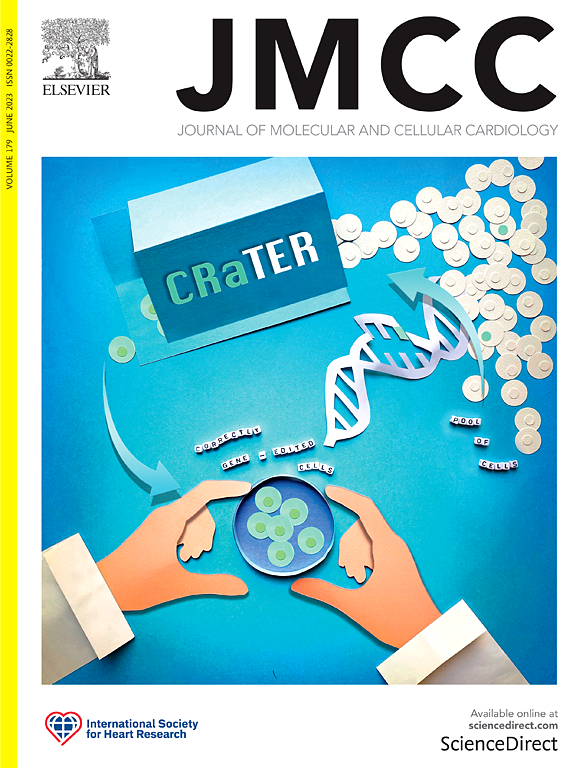SERCA2 dysfunction accelerates angiotensin II-induced aortic aneurysm and atherosclerosis by induction of oxidative stress in aortic smooth muscle cells
IF 4.9
2区 医学
Q1 CARDIAC & CARDIOVASCULAR SYSTEMS
引用次数: 0
Abstract
Background and aim
Our previous research indicates that sarcoplasmic/endoplasmic reticulum calcium ATPase 2 (SERCA2) dysfunction facilitates the phenotypic transformation of aortic smooth muscle cells (ASMCs) and intensifies aortic aneurysm through the regulation of calcium-dependent pathways and endoplasmic reticulum stress. Our hypothesis is that additional mechanisms are involved in aortic aneurysm and atherosclerosis induced by SERCA2 dysfunction from the perspective of ASMC phenotypic transformation.
Methods & results
In SERCA2 dysfunctional mice and their control littermates, ASMCs were isolated to analyze protein expression and cell functions, and angiotensin II was infused into these mice that were backcrossed into LDL receptor deficient background to induce aortic aneurysm and atherosclerosis. In ASMCs from SERCA2 dysfunctional mice, the cell cycle was accelerated, and proliferation and migration were enhanced, which could be reversed by SERCA agonist CDN1163 or calcium chelator BAPTA-AM. In ASMCs, SERCA2 dysfunction increased reactive oxygen species (ROS) production, activating extracellular signal-regulated kinases 1 and 2 (ERK1/2) and angiotensin II/angiotensin II type 1 receptor (AT1R) pathways. Both ERK1/2 and angiotensin II/AT1R activations are implicated in SERCA2 dysfunction-induced ASMC phenotypic transformation and ROS production. The redox modulator Tempol suppressed ERK1/2 and angiotensin II/AT1R pathways, inhibiting ASMC phenotypic transformation and alleviating angiotensin II-induced aortic aneurysm and atherosclerosis.
Conclusion
SERCA2 dysfunction accelerates aortic aneurysm and atherosclerosis by inducing oxidative stress in ASMCs, with activations of ERK1/2 and angiotensin II/AT1R involved in ASMC phenotypic transformation. Inhibition of oxidative stress in ASMCs is beneficial in alleviating angiotensin II-induced aortic aneurysm and atherosclerosis caused by SERCA2 dysfunction.

SERCA2功能障碍通过诱导主动脉平滑肌细胞氧化应激加速血管紧张素ii诱导的动脉瘤和动脉粥样硬化。
背景与目的:我们之前的研究表明,肌浆/内质网钙atp酶2 (SERCA2)功能障碍通过调节钙依赖途径和内质网应激,促进了主动脉平滑肌细胞(ASMCs)的表型转化,并加剧了主动脉瘤。我们的假设是,从ASMC表型转化的角度来看,SERCA2功能障碍诱导的主动脉瘤和动脉粥样硬化涉及其他机制。方法与结果:在SERCA2功能障碍小鼠及其对照组中,分离ASMCs,分析其蛋白表达和细胞功能,并将血管紧张素II注入回交到LDL受体缺陷背景的小鼠中,诱导主动脉瘤和动脉粥样硬化。在SERCA2功能失调小鼠的ASMCs中,细胞周期加快,增殖和迁移增强,这可以通过SERCA激动剂CDN1163或钙螯合剂BAPTA-AM逆转。在ASMCs中,SERCA2功能障碍增加活性氧(ROS)的产生,激活细胞外信号调节激酶1和2 (ERK1/2)和血管紧张素II/血管紧张素II型1受体(AT1R)途径。ERK1/2和血管紧张素II/AT1R激活都与SERCA2功能障碍诱导的ASMC表型转化和ROS产生有关。氧化还原调节剂Tempol抑制ERK1/2和血管紧张素II/AT1R通路,抑制ASMC表型转化,减轻血管紧张素II诱导的主动脉瘤和动脉粥样硬化。结论:SERCA2功能障碍通过诱导ASMC氧化应激加速了动脉瘤和动脉粥样硬化,ERK1/2和血管紧张素II/AT1R的激活参与了ASMC表型转化。抑制ASMCs中的氧化应激有助于缓解血管紧张素ii诱导的SERCA2功能障碍引起的主动脉瘤和动脉粥样硬化。
本文章由计算机程序翻译,如有差异,请以英文原文为准。
求助全文
约1分钟内获得全文
求助全文
来源期刊
CiteScore
10.70
自引率
0.00%
发文量
171
审稿时长
42 days
期刊介绍:
The Journal of Molecular and Cellular Cardiology publishes work advancing knowledge of the mechanisms responsible for both normal and diseased cardiovascular function. To this end papers are published in all relevant areas. These include (but are not limited to): structural biology; genetics; proteomics; morphology; stem cells; molecular biology; metabolism; biophysics; bioengineering; computational modeling and systems analysis; electrophysiology; pharmacology and physiology. Papers are encouraged with both basic and translational approaches. The journal is directed not only to basic scientists but also to clinical cardiologists who wish to follow the rapidly advancing frontiers of basic knowledge of the heart and circulation.
文献相关原料
公司名称
产品信息
索莱宝
4′,6-diamidino-2-phenylindole phenylindole (DAPI)
索莱宝
dihydroethidium (DHE)
索莱宝
Hoechst 33258

 求助内容:
求助内容: 应助结果提醒方式:
应助结果提醒方式:


